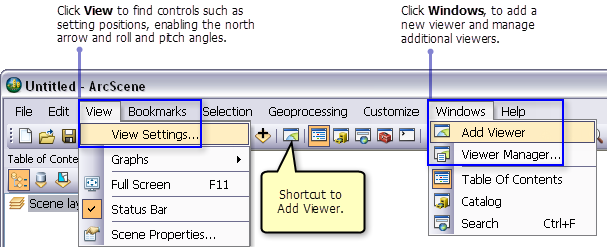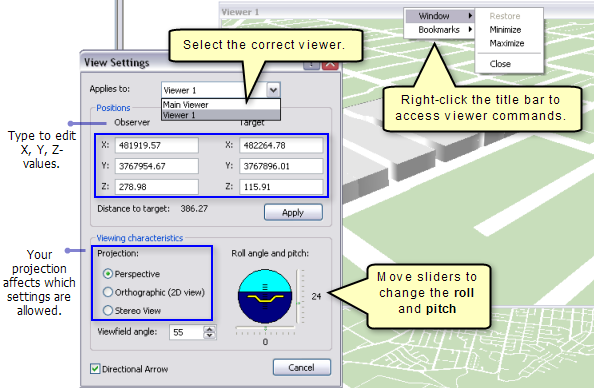Available with 3D Analyst license.
About multiple 3D viewers
By default, ArcGlobe and ArcScene have a single 3D view window, but you can create secondary viewer windows as well. Additional viewers allow you to focus on specific areas from a variety of angles while still seeing the whole 3D view. The additional 3D views are not dockable, so they can freely be arranged around your desktop.
You can navigate independently within each viewer window, since the navigation tools control the view within the active window they are used in. You can even make the 3D view rotate in one viewer while navigating in another.
Additional viewers work the same inside both ArcGlobe and ArcScene. You can
- Create multiple viewers for the current 3D view.
- Maximize viewers to fill the screen.
- Minimize viewers to get them out of the way.
- Restore viewers to their previous size.
- Close viewers altogether.
- Create and use bookmarks independently of the main 3D view.
There are also property settings to change the way you see a 3D view inside each additional view window. You can
- Change the roll and pitch of the viewer.
- Change the position of a viewer and its target point by typing x-, y-, and z- coordinates.
- Activate the Directional Arrow navigation graphic.
- Switch a viewer between perspective, orthographic (2D), and stereo views.
- Only ArcScene supports stereo viewing.
Managing additional 3D viewers
When using additional 3D viewers, there are some controls to keep in mind for certain tasks. Here is a collection of steps for using 3D viewers in ArcScene such as adding, removing, using the Viewer Manager dialog box, controlling view settings, and other tips.
How to add and remove viewers
- Click Windows and click Add Viewer.
- To close a viewer
- Right-click the title bar of the viewer and click Window > Close.
- Click the X in the top right corner of the viewer.
 on the Standard toolbar.
on the Standard toolbar. Using the Viewer Manager
The Viewer Manager is a set of controls for additional 3D view windows. It lists all viewers that have been defined for your current ArcScene document. You can click the viewer you want to manage, and controls will be enabled as they apply. All controls are disabled until a view has been selected.
- Click Windows and click Viewer Manager.
The Viewer Manager window will appear in the display.
- Click a viewer in the Select viewer list.
- Click Hide to hide the selected viewer.
When a viewer is hidden, its name appears gray in the list. Click Show on the Viewer Manager to have the hidden viewer return to the display.
- Click Restore, if you have a minimized viewer, to restore it to its previous size.
- Alternatively, right-click the title bar of the minimized viewer and click Window > Restore.
- Click Close Viewer(s) to permanently close the viewer.
- Click OK to close the Viewer Manager.
The following image illustrates where each command is located inside the ArcScene application.

- A minimized viewer shrinks to the bottom of your screen.
- A maximized viewer expands to cover your entire screen display.
- A restored viewer returns to its original size before being minimized or maximized.

How to change the roll and pitch of a viewer
Roll and Pitch are rotation angles around the line between the Observer and Target positions. In ArcScene, roll and pitch are only applicable in perspective viewing. If you have the viewer set to Orthographic, the pitch and roll controls are disabled.
Using the View Settings dialog box, there are sliders for both roll and pitch angles which you can interactively drag, adjusting the horizon.
- Click View and click View Settings.
- Click the roll angle slider and drag it to change the roll. The artificial horizon and the viewer roll to the new roll angle.
- Click the pitch slider and drag it to change the pitch. The artificial horizon and the viewer pitch to the new pitch angle.
- Click Cancel to close the View Settings dialog box.
Specifying the coordinates of the observer or target
- Click View > View Settings.
- Type the x-, y-, and z-coordinates for the observer.
- Type the x-, y-, and z-coordinates for the target.
- Click Apply to set the viewer to the new observer and target coordinates.
- Click Cancel to close the View Settings dialog box.
In the screen capture above, you can see the View Settings dialog box and where to enter your positions for observer and/or target.
Setting a Viewer to 2D in ArcScene
Setting the projection to orthographic sets the observer to looking straight down from above. The scene looks two-dimensional (2D), like a map.
When the scene is in orthographic projection, you can only edit the observer's position, not the target's.
- Click View > View Settings.
- If you have more than one viewer window open, click the drop-down arrow and click the viewer that you want to change.
- Click Orthographic (2D view). You see an orthographic view of the scene with no perspective distortion of scale.
- Click Cancel to close the View Settings dialog box.
Activating the directional arrow to help with navigation
Orient yourself in ArcScene using the directional arrow graphic.
- Click View > View Settings and select the appropriate viewer.
- Check the Directional Arrow box at the bottom of the window.
- Click Cancel to close the View Settings dialog box.
Using bookmarks in additional viewers
3D bookmarks save a particular camera perspective to be referred to at any time.
Bookmarks for 3D viewers work the same as they do for the main viewer. Regardless of which viewer a bookmark is created in, it is saved to a central list where it can be applied to any viewer. To use bookmarks for the main viewer, use the Bookmarks menu on the ArcScene interface. To use bookmarks for secondary viewers, right-click the title bar of each additional viewer.
- Right-click the title bar and point to Bookmarks in the secondary 3D viewer.
- Choose from the following 3D bookmarks options:
Create a new bookmark.

- Click Create Bookmark.
- Provide a name for the bookmark and click OK to close the Create Bookmark window.
Zoom to a bookmark.

- Click the name of the bookmark you want to zoom to.
Manage bookmarks.

- Click Manage Bookmarks.
- Select a bookmark from the list and use the options provided, such as Remove (Selected or All), Load, and Save.